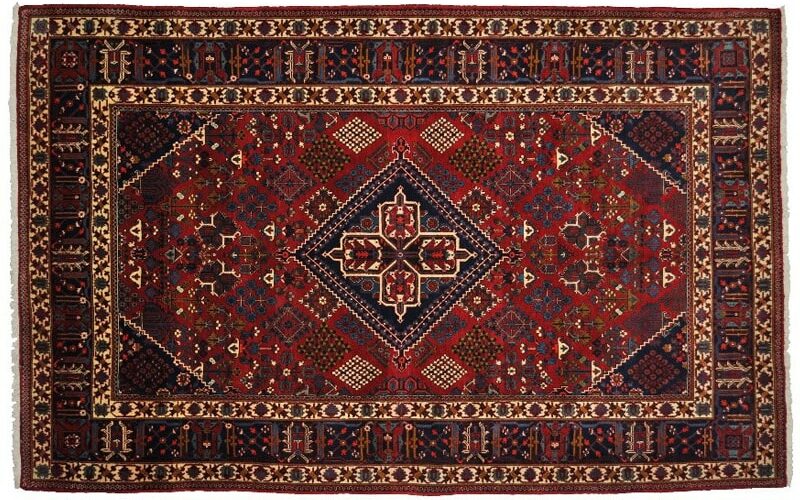Many Iranian cities and villages are famous for their rug-weaving tradition, giving their names to their products. Still, it is only Josheghan that has gained its nickname after a type of rug! This article will find out more about the story behind the Josheghan rug. And their universal pattern has inspired so many Persian rug weavers through history.
Where is Josheghan?
High above Karkass Mountain, looking down at the hot desert, Josheghan is chilled by the surrounding snow-peaked hills. Here is the spot where a branch of Zagros ends in the desert between Isfahan and Kashan. The pointy hills of marble, iron, and azure glow in various shades around villages. A landscape with a deep affinity for the unique rug design comes from this town.
Three Iranian villages, at least named Josheghan, are around Kashan, Kashan of Isfahan Province. Naturally, these two have bynames: Josheghan-e Astarak ‘Ashtarak’s Josheghan’, and Josheghan-e Qali Josheghan the Rug(-center). The name may also be Romanized as ‘Joshegan and ‘Jowshaghan.’
The town gained its reputation as a rug weaving center under the Safavid Shahs. The cool, healthy air made Josheghan a favorite summer residence for Shah Abbas, the Great, and his court.
Royal rug workshops were also established there for upland pastures and excellent water. This is what provided the fine wool and superior herbal and mineral dyes.
Great artisans such as master weavers and dyers came to the town from distant places. At the height of its glory, Josheghan produced royal rugs and carpets. And, this is not only for the Persian Court but also for the Indian Mughal Court.
Dyeing and Painting of Josheghan Rug
The fertile soil of the region provides herbal and mineral dyestuffs. Red and dark blue are dominant for grounds, including deep reds as well as acid-moderated pinks.
For secondary shades, Josheghan’s palette is diverse. It consists of azure, cobalt, midnight blues, pistachio, light, dark greens, yellows, oranges, and white and ivory.


Designs and Patterns of the Josheghan Rug
The Josheghan rug has woolen piles on a cotton foundation. Knots are asymmetric (Persian) with a density between 100 and 200 per square inch. Josheghan rugs are usually woven without loom-drawing.
Art historians refer to some Persian designs as ‘universal.’ Herati (Mahi) and Lachak-Toranj (central medallion) being the most famous ones. One could mention Josheghan could do so, though it does not have multiple versions as the others. The design has a structure of its own, named after a mountainous village in the heart of the Iranian deserts. This is located between Isfahan and Kashan. It was once the primary center for the Safavid royal rug workshops, in which a classic version still is woven.
The classic version of Josheghan is an all-over lozenge pattern, each lozenge consisting of a fine rectilinear floral motif. In other words, rectilinear floral motifs, framed with invisible vertical lozenges, fill the ground. And, at the same time, make a lattice of neat geometric sprays, leaves, and flowers. Such neatly rendered patterns may appear curvilinear at first glance.


There are interpretations of the design in which frames tend to ovals with actual leafy lines. Zagros folks have various framed designs. Some experts tend to call these designs ‘Josheghan’ too if their frames tend to lozenges. This is true about Isfahan and Kashan’s Qab-Qabis (Framed) designs and modern interpretations.
In antique Josheghans, sometimes the lozenges surround a bigger lozenge that serves as a central medallion. In some cases, such a central medallion could be deemed just by the difference of colors or type of floral motifs. And this is present while examples with certain central medallion and corners are also numerable. And some with large corners and tiny stellar medallions, others with medium corners and medium round medallions.
Repeats of diamonds give a tiled feature to designs through the Josheghan rug, which has been woven without loom drawings.
The Antique Josheghan Rug
The design is not older than four centuries, which may be a young age for a Persian thing! There are antique and semi-antique tribal interpretations of the design as well as city-woven rugs. These are traditionally woven in Meimeh, the neighboring town of Josheghan-e Qali village. Other Persian weaving centers have widely copied it during the recent century. Moreover, today the modern designers imitate the Josheghan design frequently.
The most famous design attributed to Josheghan is an all-over lozenge pattern. Each lozenge consists of a fine rectilinear floral motif. In other words, rectilinear floral motifs, framed with invisible vertical lozenges. And, these fill the ground to make a lattice of neat geometric sprays, leaves, and flowers. Such neatly rendered patterns may appear curvilinear at first glance.
If you liked Josheghan rugs after reading this blog, we highly recommend you to check out our collection of top-grade ones in our Louisville, KY Rug Store. Don’t forget to pay us a visit to discover and find out more of our charming rugs.

